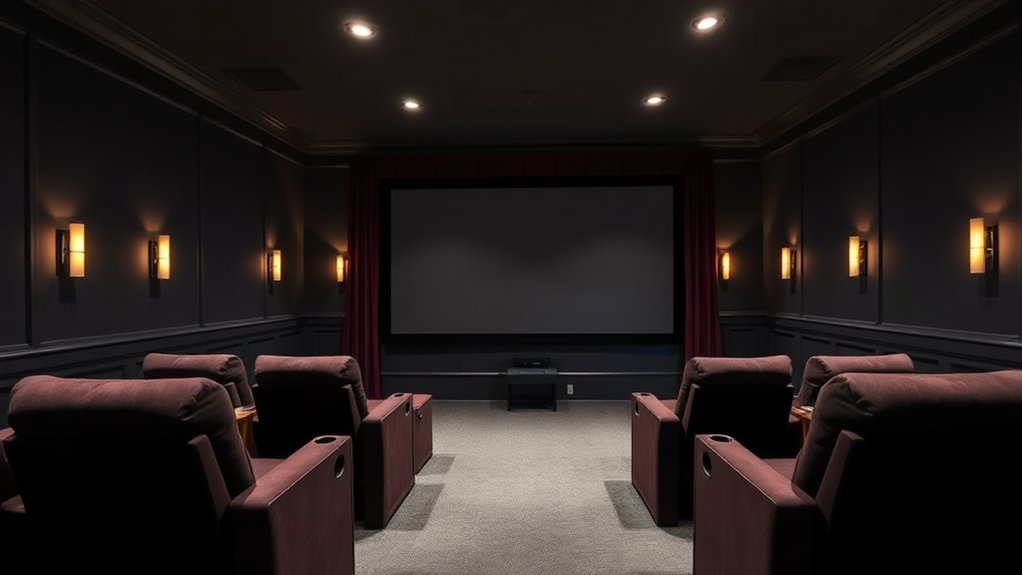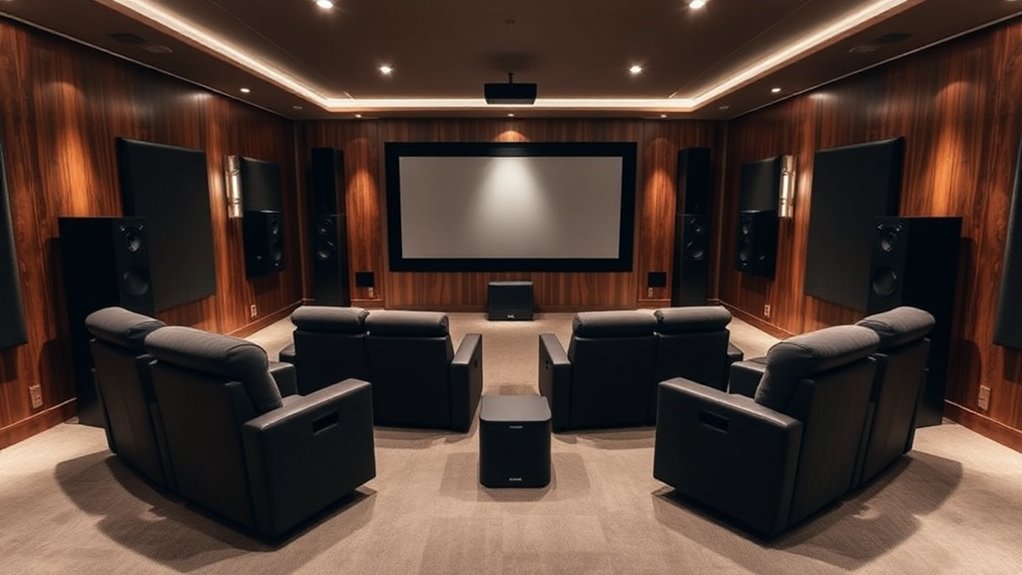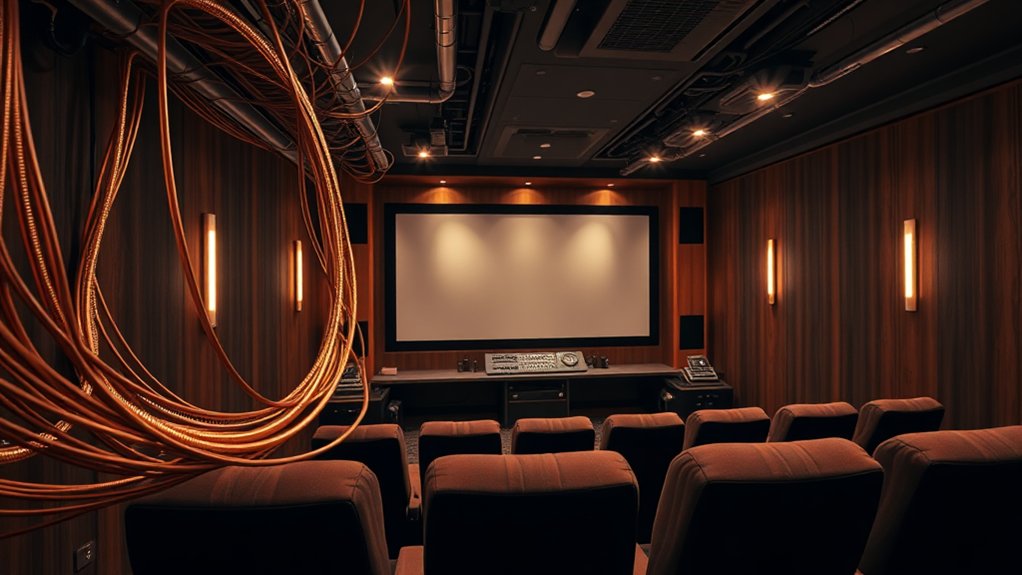Regarding theater rooms, dark-colored walls are your best friend. Think matte black or deep gray; these colors absorb light, reduce glare, and improve contrast, making your movie experience truly immersive. Imagine watching your favorite film without those annoying reflections stealing the spotlight—sounds great, right? Plus, dark hues create a cozy vibe, elevating the entire atmosphere. If you’re curious about how to incorporate these colors into your overall design, there’s more to investigate!
Key Highlights
- Dark-colored walls, especially black, minimize light reflection and enhance color contrast for an optimal viewing experience.
- Matte finishes absorb ambient light and reduce glare, improving overall picture quality.
- Dark gray or navy blue walls provide a modern, cozy atmosphere while complementing various design styles.
- Avoid light colors, as they create reflections that diminish contrast and draw attention away from the screen.
- Dark hues also enhance sound acoustics, creating a more immersive environment for movie watching.
Importance of Wall Color in Theater Design
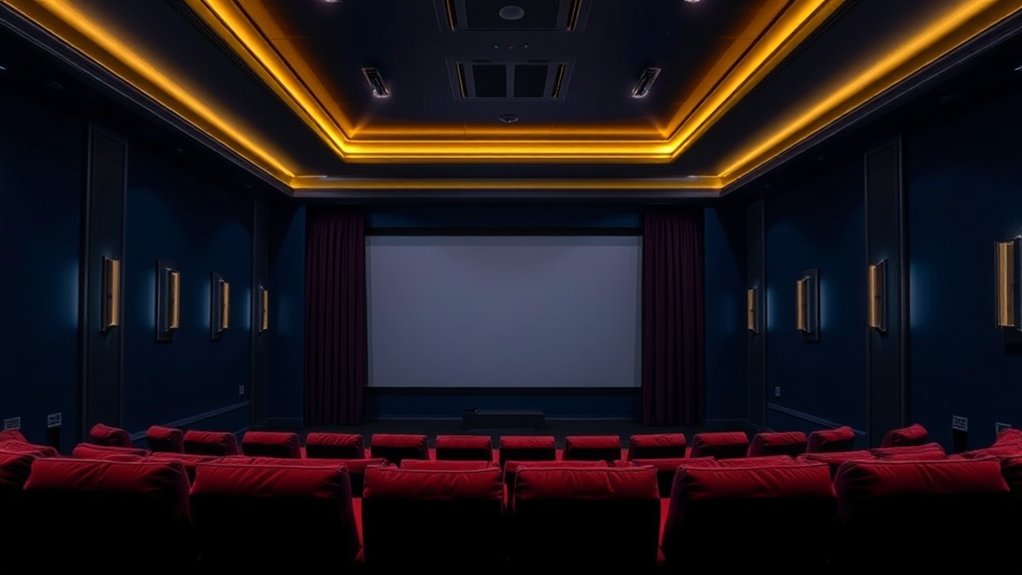
When designing a theater room, the importance of wall color can’t be overstated; after all, the right shade can greatly improve your movie-watching experience. Dark-colored walls, like deep blues or grays, reduce light reflection, making it easier to focus on the screen without distractions. Additionally, darker hues can enhance the overall design aesthetics of the room, creating an inviting atmosphere for movie nights. A matte or flat finish is essential, as it elevates contrast perception, pulling you deeper into the cinematic world. Conversely, lighter hues can cause annoying glare that washes out your favorite films. Think of it this way: do you want your movie adventure sabotaged by unwelcome reflections? Not all dark colors are created equal, either; opting for matte finishes elevates contrast perception, pulling you deeper into the cinematic world.
Plus, a dark ceiling keeps stray light in check too, ensuring your viewing quality stays high-quality. So go ahead, welcome those moody vibes!
Benefits of Dark and Matte Finishes
Even though you might be tempted to think that any paint color will do, the benefits of dark and matte finishes in theater rooms are hard to ignore.
First off, matte finishes absorb ambient light, minimizing distractions like glare—who wants to squint at a movie? Dark colors, paired with a matte look, heighten contrast, allowing those rich, vivid images to pop on the screen (seriously, who doesn’t love brilliant colors?). Additionally, optimal colors for theater walls include flat black paint or fabric frames to enhance image quality. Furthermore, these choices contribute to a cozy and focused viewing space that enhances the overall viewing experience.
Plus, these surfaces help with acoustics, reducing sound reflections, which means clearer dialogue and less echo (because nobody wants to ask, “Wait, what did they say?”).
Finally, dark matte walls create a cozy, immersive atmosphere—perfect for diving deep into your favorite film without distractions. Sounds appealing, right?
The Case for Black Walls
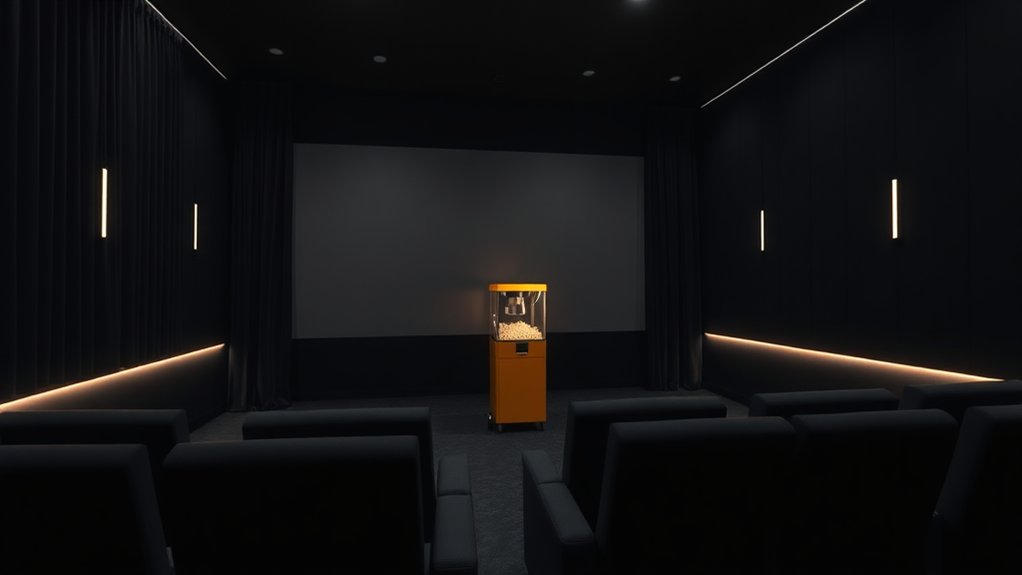
The allure of black walls in theater rooms goes beyond mere aesthetics; they play a pivotal role in crafting an immersive cinematic experience that truly enthralls.
The charm of black walls in home theaters enhances immersion, transforming viewing into an enthralling cinematic adventure.
By absorbing ambient light, black walls minimize reflections that could wash out the image on your screen—an absolute dream, right? This absorption improves contrast, making colors pop and images feel more dynamic.
As a bonus, black walls additionally create a natural frame, keeping your attention glued to the action.
On the acoustic front, black panels not only look sleek but can as well reduce sound reflections and external noise, ensuring a clearer audio experience. Incorporating materials like SilentCeiling™ Black Theater Board can further enhance this acoustic performance, making your movie nights even more enjoyable.
Exploring Gray and Other Dark Hues
Even though black walls often steal the spotlight, gray and other dark hues can also transform your theater room into an enthralling cinematic escape.
Dark gray, for instance, offers a sleek, modern vibe that’s both tranquil and moody—perfect for movie marathons. Its ability to absorb stray light raises the visual contrast on your screen, keeping the focus right where it belongs. Plus, gray’s versatility complements various styles as it adds a hint of character without overwhelming the space.
Then there’s navy blue, which promotes coziness and immersion.
Light Colors to Steer Clear Of
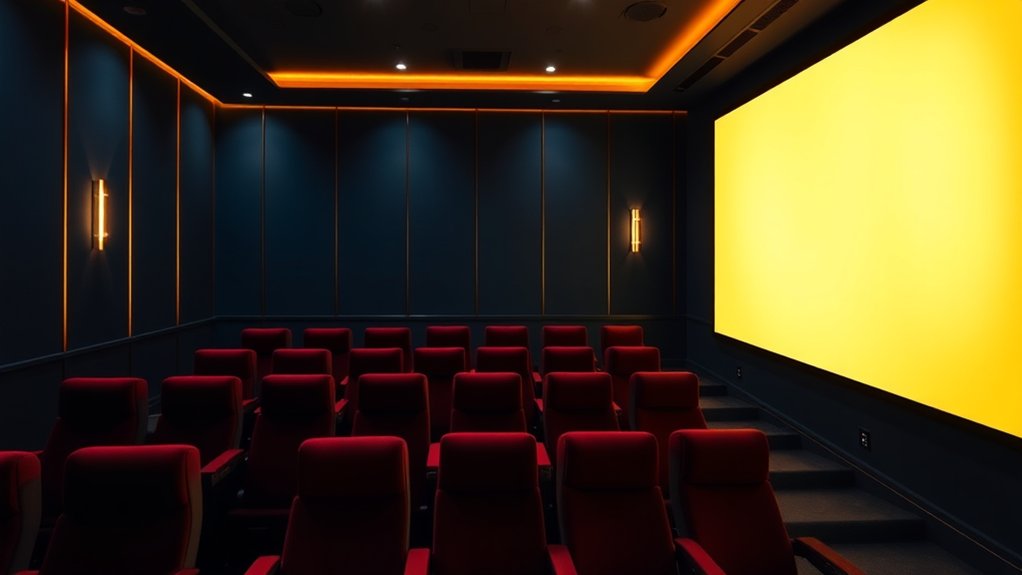
In regards to creating the perfect theater room, light colors shouldn’t even make the shortlist, and here’s why: light shades like whites, creams, and pastels bounce light around the room, creating glare that can spoil your cinematic experience.
The reflected light reduces picture quality and diminishes contrast, making images look washed out. Plus, bright walls steal the spotlight, competing for your attention instead of letting you focus on the film. If you’ve ever noticed eye strain during a movie—well, it’s likely because of those bothersome reflections.
And let’s be real—who wants to constantly clean scuffs and marks? Instead, aim for darker hues that welcome the immersive environment you crave.
Trust me, your movie nights will thank you!
Impact of Wall Color on Room Perception
Choosing the right wall color can greatly affect how you perceive your theater room, and it’s not just about aesthetics. Dark colors like black or deep blue reduce light reflection, making your screen easier to see. They as well create a cozy, intimate vibe that helps you tune out distractions and get lost in your movie.
Conversely, cool tones such as blue and green promote relaxation, expanding the perceived space, which can be perfect for winding down after an action-packed flick. Meanwhile, warm colors might energize the atmosphere, but they often reflect too much light, leading to potential glare.
Practical Tips for Choosing Paint
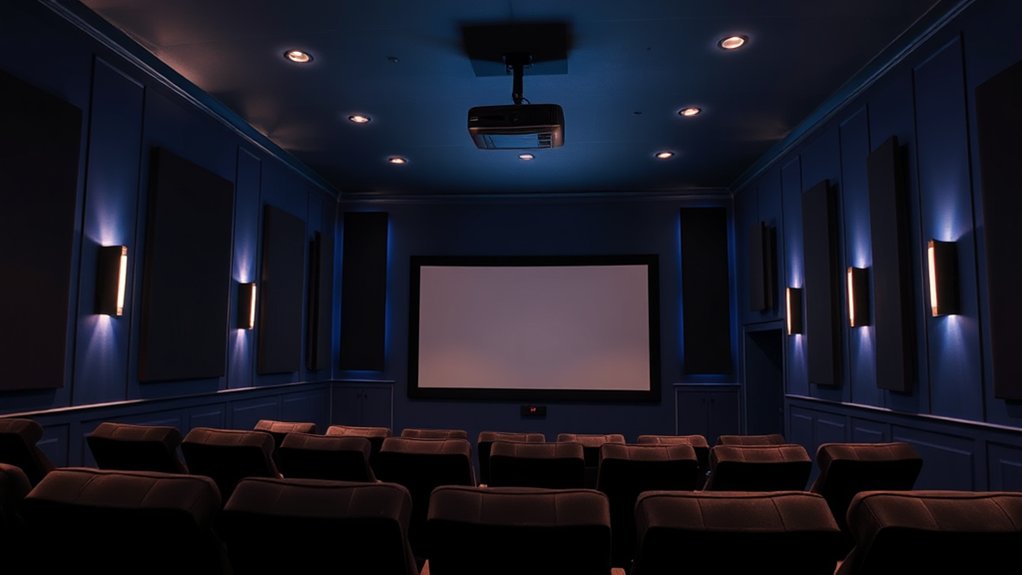
Finding the right paint for your theater room isn’t just about picking your favorite color; it’s a blend of aesthetics, functionality, and sound quality that all work together to boost your viewing experience.
Start by choosing dark, matte paint colors like charcoal gray or navy blue, which absorb ambient light, improve contrast, and create a cozy atmosphere. Testing samples on your walls is essential, as lighting can drastically alter the appearance.
Opt for dark, matte colors like charcoal gray or navy blue to enhance contrast and create a welcoming theater ambiance.
Think about the room’s multipurpose use, too; pure black might deliver the best image quality, but you wouldn’t want to trip over your popcorn in the dark!
Finally, consider how the paint will interact with acoustic treatments for the best sound quality, since who wants to miss a single line of dialogue?
Integrating Color With Overall Room Design
When you think about integrating wall color with your theater room’s overall design, keep in mind that the right choice can raise both style and functionality—after all, who wants a beautiful setup if it doesn’t improve the viewing experience?
If you’re leaning toward black walls for that immersive feel, remember they absorb light effectively, enhancing contrast.
Nevertheless, if your room serves multiple purposes, consider neutral dark colors like deep blues or muted reds—they reduce glare during offering warmth.
Think about your furniture too; browns and deep reds pair nicely, as long as you choose complementary accents.
Just avoid glossy finishes on walls; they might distract instead of focusing your attention on that epic film moment.
Frequently Asked Questions
What Paint Brands Are Recommended for Theater Room Walls?
When choosing paint brands for theater room walls, consider Sherwin-Williams Tricorn Black, Behr Ultra Pure White, and Rosco Velour Black. These options provide excellent light absorption and a non-reflective finish, enhancing your cinematic experience.
Can I Use Wallpaper in a Theater Room Instead of Paint?
Yes, you can use wallpaper in a theater room instead of paint. Wallpaper offers durability, hides imperfections, and can improve acoustics, but make certain you choose designs that minimize glare and won’t reflect projector light.
How Often Should I Repaint Theater Walls for Maintenance?
You should repaint theater walls every 3 to 7 years, depending on usage, dampness, and light exposure. Regular inspections and touch-ups will help maintain aesthetics and prolong the life of your wall finishes.
Are There Specific Materials to Avoid Behind Wall-Mounted Screens?
You should avoid reflective materials, glossy finishes, and textured surfaces behind screens. Moreover, steer clear of hollow walls and materials that degrade over time. Choosing the right materials guarantees peak screen performance and audio quality.
How Do Wall Colors Affect Sound Quality in Theater Rooms?
Wall colors greatly influence sound quality. Dark hues improve bass perception whereas lighter shades accentuate treble. Choosing matte finishes and acoustically treated materials helps absorb sound, reducing echoes and refining your theater’s overall audio clarity.

